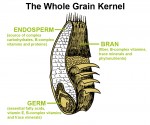 We all keep hearing that we need to eat more whole grains, but does everyone know what they are? It's pretty obvious they are NOT that swishy white bread that we used to make dough balls out of when we were kids (to use for bait while fishing!). Whole grains are cereal grains that consist of the intact, ground, cracked or flaked kernel, which includes the bran, the germ and the inner most part of the kernel (endosperm). Examples of whole grains include whole wheat, oatmeal, whole-grain cornmeal, brown rice, whole-grain barley, whole rye, and buckwheat.
We all keep hearing that we need to eat more whole grains, but does everyone know what they are? It's pretty obvious they are NOT that swishy white bread that we used to make dough balls out of when we were kids (to use for bait while fishing!). Whole grains are cereal grains that consist of the intact, ground, cracked or flaked kernel, which includes the bran, the germ and the inner most part of the kernel (endosperm). Examples of whole grains include whole wheat, oatmeal, whole-grain cornmeal, brown rice, whole-grain barley, whole rye, and buckwheat.
When checking the ingredient list, it is best if they list the whole grain first on the list (usually the most abundant of the ingredients). The general recommendation is to have have three one-ounce equivalents of whole grains daily to help reduce the risk of chronic disease such as heart disease and cancer.
Examples of a one ounce equivalent are:
- 1/2 cup cooked oatmeal
- 1/2 cup cooked 100% whole-grain pasta
- 1/2 cup cooked brown rice or whole-grain barley
- 1 regular slice of 100% whole-grain breast
- 1 cup of whole-grain ready-to-eat cereal (flakes or rounds) or 1 1/4 cup puffed.

Comments